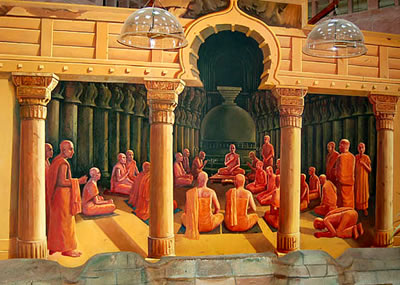What is Buddhism?
“Shun anger, let go of pride, break out of every shackle. Whoever is not tied to possessions, clinging neither to body nor mind, is never in bondage. Whoever controls their anger is like a true charioteer, in command of the rolling chariot and not just holding onto the reins.”
-The Buddha, from the Dhammapada

Buddhism is, simply, a path of liberation from suffering. The Buddha showed that all sentient beings can end their suffering and provided a means by which this may be accomplished. Buddhism’s core teachings are the Four Noble Truths and the Noble Eightfold Path.
The Buddha was born in 563 BCE (see The Buddha) in the foothills of the Himalayas, attained Enlightenment at the age of 35 and taught for another 45 years until his death, known as the Parinirvana (Passing into Nirvana).
The Spread of Buddhism
Following the Parinirvana, many of the Buddha’s disciples gathered to recall and recite the Buddha’s teachings. Some of the more notable disciples included Moggallana, Sariputra, Mahakashapa, and Ananda who was also the Buddha’s cousin. The initial gathering of disciples was known as the First Council. Three more major councils were held over the next 300+ years, by which time the Buddha’s teachings were being written down. These teachings were collected into what became the Sutta Pitaka, which, when joined with the Commentaries on the Teachings (Abhidharma Pitaka) and the Rules of Discipline (Vinaya Pitaka) produced the Tripitaka, or “Three Baskets,” also referred to as the Pali Canon.


Around the first century BCE, various sub-sects began to form and newer scriptures and commentaries began to appear. This was the beginning of what we now know as Mahayana, or Wider Vehicle Buddhism. The original form of Buddhism was later termed Theravada, meaning “Teaching of the Elders.” Where the ideal figure of Theravada Buddhism was the Arhat, a being who has single-handedly attained Enlightenment and is no longer subject to death and rebirth, the Mahayana’s ideal figure was the Bodhisattva, or “Enlightening Being,” one who aspires to Supreme Enlightenment and is devoted to assisting all sentient beings to attain Supreme Enlightenment. A Bodhisattva also aspires to Buddhahood as another way to assist sentient beings.
The Mahayana division of Buddhism matured philosophically and scripturally in India, and these seeds matured into Buddhist sects as the teachings spread to east Asia, particularly China. Theravada Buddhism remained in the land of its birth, but also spread to Sri Lanka and southeast Asia. In the 8th century CE, a movement to bring Buddhist practice and teaching to the Himalayas began, led by the Indian philosopher Padmasambhava. As Buddhism grew in the Himalayas, and especially in Tibet, a new kind of Buddhism known as Vajrayana or “Diamond Vehicle” Buddhism came into being.

Coming to the West

Due to geographical factors and a wave of invasions, Buddhism was unable to establish a permanent foothold in Central Asia and beyond. Buddhism flourished from India eastward to Japan for hundreds of years but did not begin to make its way to the west in any significant fashion until the 17th century CE when a few Buddhist texts were translated into Latin. In the 18th century, European scholars began to collect and study a number of Buddhist texts. In the 19th century, European archeologists in India began to uncover sites of importance in Buddhist history such as the Lumbini Garden where the Buddha was born. The Theosophical Society made the teachings of the Buddha even more well-known in the western world. Societies for the study of Buddhism sprang up in Europe, and copies of Buddhist texts from the great European universities began to make their way to North American academic centers.
Ethnic Buddhists from China, Korea, Japan and other east Asian nations emigrated to North America and brought their faith with them, establishing temples on the west coast. Meanwhile, the academic centers on the east coast of North America were key in disseminating Buddhist texts and ideas. Writers like Ralph Waldo Emerson and Henry David Thoreau were popularizing their own brand of transcendentalism, and they both indicated that they were very interested in Indian ideas. Societies for Buddhist study and practice sprang up in England and many were transplanted to North America.


Noted author Alan Watts coined the phrase “Beat Zen” to describe a free-wheeling kind of Zen that had become fashionable on the west coast in the 50s. Beat Zen was also reflected in the attitudes and writings of the Beat Poets like Gary Snyder and the novelist and poet Jack Kerouac. In a relatively short time, their works helped to bring Buddhism into the mass consciousness of westerners.
Following the Second World War, many Americans became interested in Japanese Zen Buddhism. A number of Zen Buddhist temples and groups were established in California to go along with the ethnic Buddhist temples already present, and by the 1960s many Americans were exploring Buddhism as an alternative to traditional western religions.
Buddhism Today
North Americans can now avail themselves of a wide variety of Buddhist forms. From Chan to Tibetan to Pure Land and beyond, every sect of all three divisions of Buddhism is represented here. Buddhism does not actively seek converts, which means that people of any faith tradition are welcomed and encouraged to take advantage of Buddhist teachings and meditative practices to strengthen their own spirituality. There has been yet another Buddhist revival in the People’s Republic of China where an increasingly modernized population is beginning to look for greater spiritual fulfillment. Having become all but extinct in the land of its birth, Buddhism has also made a comeback in India where the exiled Dalai Lama of Tibet has his headquarters. Modern psychotherapists are incorporating Buddhist meditation styles into their treatment modalities, and the Internet has caused an exponential increase in the awareness of Buddhism and its teachings worldwide. Considered to be the world’s fourth-largest major religion, Buddhism offers a philosophy of peace, loving-kindness, compassion and enlightened wisdom in a world whose constantly changing nature is a challenge to all humanity.

